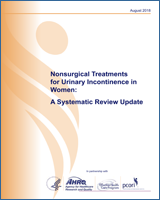From: Results

NCBI Bookshelf. A service of the National Library of Medicine, National Institutes of Health.
| Interventions* | OR (95% CI) † | |||||
|---|---|---|---|---|---|---|
| BTX (B) | 4.89 (2.75, 8.69)‡ | 3.03 (1.45, 6.35)‡ | 1.35 (0.90, 2.05) | 1.18 (0.23, 6.11) | 1.58 (0.80, 3.15) | 12.7 (7.44, 21.6)‡ |
| Antichol (C) | 0.62 (0.39, 1.01) | 0.28 (0.18, 0.42)‡ | 0.24 (0.05, 1.23) | 0.32 (0.19, 0.54)‡ | 2.60 (2.05, 3.28)‡ | |
| Antichol + Behavioral Tx (C+T) | 0.45 (0.24, 0.83)‡ | 0.39 (0.07, 2.11) | 0.52 (0.26, 1.04) | 4.18 (2.48, 7.07)‡ | ||
| Neuromod (N) | 0.87 (0.18, 4.29) | 1.16 (0.67, 2.04) | 9.37 (6.64, 13.2)‡ | |||
| Neuromod + Behavioral Tx (N+T) | 1.34 (0.25, 7.10) | 10.7 (2.14, 53.9)‡ | ||||
| Behavioral Tx (T) | 8.04 (4.91, 13.2)‡ | |||||
| Placebo/Sham/No Treatment (P) |
Cells with data shaded gray indicate that the estimate is based only on indirect comparison. Results are given as odds ratios (95% confidence intervals). Odds ratios >1 favor the row intervention (to the left) over the column intervention (below). Comparisons below the diagonal are omitted (blank cells).
Abbreviations: Antichol = anticholinergics, CI = confidence interval, OR = odds ratio; BTX = onabotulinum toxin A.
Interventions are listed across the diagonal line of table cells. Intervention category codes are in parentheses, corresponding with the associated figure.
In all cells with numerical data.
Statistically significant. These cells are also in bold font to improve visibility.
From: Results

NCBI Bookshelf. A service of the National Library of Medicine, National Institutes of Health.